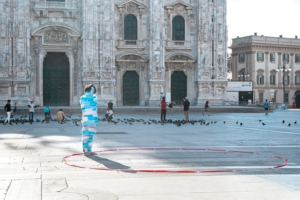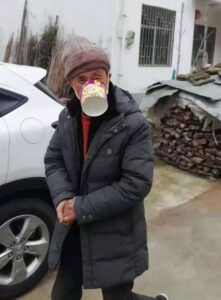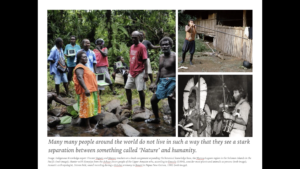[Week 2]A little thinking toward environmental design
This week we just finished our first lecture recordings, and I have to say it was a pity that we can only meet, discuss and learn through the internet.
- At first, we’ve taken through an introductory seminar where we shared a certain of examples to interpret the relationship between people and the environment. And now I will draw some points to my example.
It is a planning document called “The Copenhagen Cloudburst Formula by Ramboll and Ramboll Studio Dreiseitl” which has grabbed the 2016 ASLA Analysis & Planning Award of excellence. Firstly, the background of this project was based on a 2011 cloudburst that caused damage of approximately USD $1billion and raised people’s awareness toward climate change mitigation solution. We could see such a project as a combination of different areas like planners, engineers, designers and economists…etc, maybe sponge city could describe it clearly.

Sponge city can be separated into three parts – store water, water purification and release&use, which aim to compose a water recycling system for assuring biodiversity and sustainable development. There are lots of countries putting their attention on this conception like LID(Low Impact Development), SuDS(Sustainable Drainage Systems) and WSUD(Water Sensible Urban Design). Instead of the underground water reservoir, this project turned to the blue-green system under sunlight. It connected two changeable parts – water&greenbelt. I think the most essential point of this project is that this studio launched an overall strategy for the public due to the fact that such rain will permeate every corner of Copenhagen. Thus, residents are able to have enough reflection for in-time adjustments. That’s the example for us about how to communicate with our audience better and create unique effects.
- Secondly, I’d like to share some of my own thoughts when listening to our lecture.
For my personal definition of environment and design, I think the traditional conception of environment refers to nature and creature(maybe an organism after combination and interaction), but actually, I regard it as our surroundings cuz we couldn’t perceive all things of our planet. What we learn, get familiar to, analyze and conclude is just a small nut compared with a mysterious forest. From a very wide perspective, our nature(planet)don’t need our care or attention, what we really need to do is to take care of the human being ourselves. It originates from this home-planet history – we could see there existed numerous destruction to species like an ancient volcano burst, toxic gas, continuous earthquake and something else. If we compare our “planet” to human, it never becomes a weak and crying baby but a robust and bonny man. Well, you may be curious about what status we are, I guess we might be helminths 🙂 (commendatory or derogatory, whatever)
As for what is design, I suggest it is just unconscious and natural behaviour that can be retrospect to hominid. When a first man found the method to use fire to cook it’s design; when a first man found some herb can be medicine it’s design; when a man trying to invent a device it’s design. Design is a method that we people try to get our life better. Take booming wild design(or works) during COVID-19 for example. Can we just deny those artifacts, their correctness and rationality? Just because we are “professional”, we are “educated”? Absolutely the answer is no, and we have to admit and appreciate these design because they cover the areas we “traditional” designers never pay attention to. Meanwhile, it can be the reason why I believe we designer could change the world with a little bit slow speed. One day we will cover all the areas sooner or later.


- Next, I support the emphasized responsibility&morality&power of designers. Sometimes we may find such an occupation seems useless to practical social problems just like this COVID-19. More and more designers(maybe graphic designer or artists?) could only stay at home for months and just received lots of information passively, the exclusive output of them could be predictable – some graphs/images/small installation. However, in that emergent period what mentioned above are indeed unnecessary compared with doctors, courier, scientists and policeman. All I present here is that the function of graphic design is not to save lives and rescue the dying, there is nothing to be embarrassed. In the following learning and research, what we need to do is to absorb multi-discipline knowledge as much as we can. It’s urgent to convert our work mode from a single strategy exportation to completed causal inference. The later one needs adequate interdisciplinary foundations. So, a continuous discussion about what we design/how we design is necessary.

- Finally, I’d like to talk about the above pic. It’s important to notice the difference with people in pic and our modern citizens. Can we called them “savage” just in terms of their poor life quality and ragged clothes? Maybe not( except some extreme racist). The distinction between “nature” and “culture” may be the key for us to getting know to the reason(for dichotomy). We could interpret these notions called “humanity”/”nature” are protectable measures, persuading us that “woo~we are “human”, totally new species! Goodbye for pervious animal identity”. To some degree, it sounds like a weakness and fright exists in our blood. It may like a dramatic and tedious soup opera – our protagonist struggles for a better life from his poor street, after he makes fame and money he disdains his previous identity and is ashamed of it. Contradictory but commonplace. Take the food chain for example. People are a part of this chain but now we are trying to pick us out of this chain and try hard to become the dominator. It’s not to say we are extremely right or wrong in such a position. Just guess if other animals (maybe a new kind of monkey/dolphin/tiger/even hatred rat) realize their “existence”(I mean an individual mind) what’s their choice?
(I’m still trying to write a good weekly article till now 🙂




Hi Yanming
Welcome to the Environmental Design Course.
I am just adding a brief comment so that you know your blog post is live .
Your insights and opinions in response to the course material is insightfulI look forward to your contribution to the group discussions.
Shirley